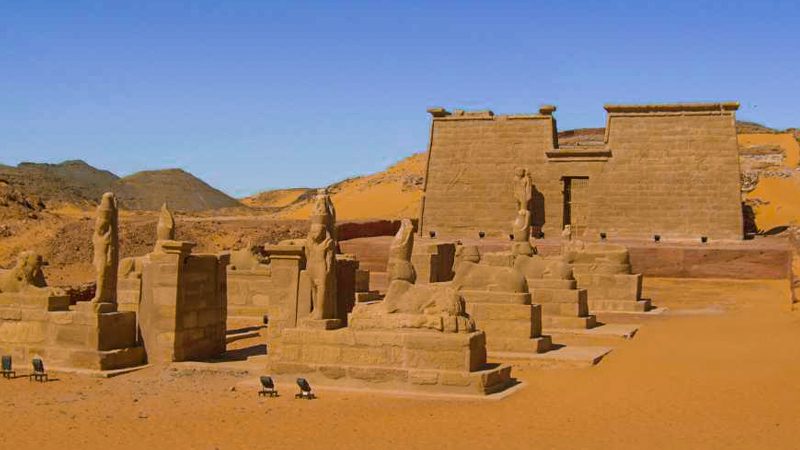Welcome to the captivating world of ancient Nubia, where history and grandeur merge seamlessly. In this article, we embark on a journey to unravel the mysteries of the Temple of Wadi El-Sebua. Nestled amidst the stunning landscapes of Sudan, this hidden gem offers a glimpse into the rich cultural heritage of ancient Nubia. Join us as we delve into the architectural wonders, historical significance, and intriguing legends surrounding this enigmatic temple.


Discovering the Temple of Wadi El-Sebua
The Temple of Wadi El-Sebua, also known as the Temple of Amun, is a testament to the grandeur of ancient Nubian civilization. Constructed during the reign of Pharaoh Ramses II, this imposing structure showcases the architectural brilliance and artistic mastery of its time. We delve into the temple’s awe-inspiring design, highlighting its majestic towers, intricate reliefs, and sacred sanctuary.
Unveiling the Secrets of Nubian History
To fully appreciate the Temple of Wadi El-Sebua, we must explore the historical context of ancient Nubia. We delve into the rich heritage of the Nubian civilization, their interactions with neighboring Egypt, and the cultural exchanges that shaped their society. Discover the unique aspects of Nubian art, religion, and language and how they are reflected in the temple’s architecture and inscriptions.
Architectural Marvels of Wadi El-Sebua
The Temple of Wadi El-Sebua is a remarkable example of Nubian architecture, blending Egyptian and Nubian influences. We delve into the intricacies of the temple’s construction, highlighting its colossal statues, finely carved reliefs, and the symbolic motifs that adorn its walls. Explore the significance of the temple’s alignment and orientation, showcasing ancient Nubian architects’ profound knowledge of astronomy.
Myth and Legend Surrounding Wadi El-Sebua
Every ancient temple carries mythical tales and legends, and the Temple of Wadi El-Sebua is no exception. In this section, we unravel the fascinating stories associated with the temple, including its connection to the legendary queen Nefertari and the journey of the sun god Amun. These tales add a touch of mystique to the temple, further deepening its allure.
Rediscovery and Preservation Efforts
The Temple of Wadi El-Sebua remained buried beneath the desert sands for centuries, hidden from the modern world. We delve into the story of its rediscovery and the subsequent preservation efforts undertaken to protect this invaluable piece of history. Learn about the challenges during excavation and the ongoing conservation measures that ensure the temple’s survival for future generations.
Cultural Significance and Tourism
Today, the Temple of Wadi El-Sebua serves as a cultural landmark and a testament to the enduring legacy of ancient Nubia. We explore the tourism potential of the temple, its accessibility for visitors, and unique experiences. From guided tours to immersive cultural encounters, discover how this hidden gem captivates the hearts of those who venture to its remote location.
What is the historical significance of the Temple of Wadi El-Sebua?
The Temple of Wadi El-Sebua holds immense historical significance as it provides insights into the rich cultural heritage of ancient Nubia. Built during the reign of Ramses II, it showcases the architectural brilliance and artistic mastery of the time. Exploring the temple offers a deeper understanding of the interactions between Nubia and neighboring Egypt.
What are the architectural features that make the Temple of Wadi El-Sebua unique?
The Temple of Wadi El-Sebua is a remarkable example of Nubian architecture, blending Egyptian and Nubian influences. Its majestic pylons, intricate reliefs, and symbolic motifs make it a visual marvel. The temple’s alignment and orientation also demonstrate the profound astronomical knowledge of ancient Nubian architects.
Are there any myths or legends associated with the Temple of Wadi El-Sebua?
Yes, the Temple of Wadi El-Sebua is steeped in fascinating myths and legends. One such code involves the temple’s connection to the renowned queen Nefertari and the journey of the sun god Amun. These tales add a touch of mystique and allure to the temple, enhancing its historical and cultural significance.
How was the Temple of Wadi El-Sebua rediscovered and preserved?
The Temple of Wadi El-Sebua remained buried beneath the desert sands for centuries until its rediscovery. Excavation efforts unveiled this hidden gem, and subsequent preservation measures have been undertaken to protect its historical value. Ongoing conservation initiatives ensure the temple’s survival, allowing future generations to appreciate its splendor.
What is the tourism potential of the Temple of Wadi El-Sebua?
The Temple of Wadi El-Sebua offers a unique and captivating experience for tourists. Its remote location adds to its allure, attracting history enthusiasts and cultural explorers. Guided tours provide insights into its historical and architectural significance, while immersive cultural encounters offer a deeper understanding of ancient Nubian civilization.
How accessible is the Temple of Wadi El-Sebua for visitors?
The Temple of Wadi El-Sebua, located in Sudan, may require some travel arrangements for visitors. However, despite its remote location, it is accessible to tourists through organized tours. It is advisable to plan and make the necessary arrangements to explore this hidden gem and witness the magnificence of ancient Nubian architecture.
Don’t miss out! Read the full story
Conclusion
The Temple of Wadi El-Sebua stands as a testament to the remarkable achievements of ancient Nubia. Its architectural splendor, historical significance, and captivating legends make it a must-visit destination for history enthusiasts and cultural explorers. Let the temple’s grandeur transport you to a bygone era, where the echoes of Nubian civilization still resonate today.
